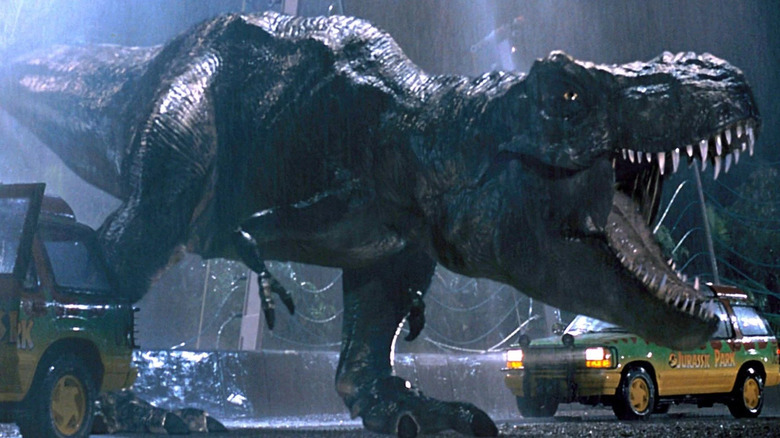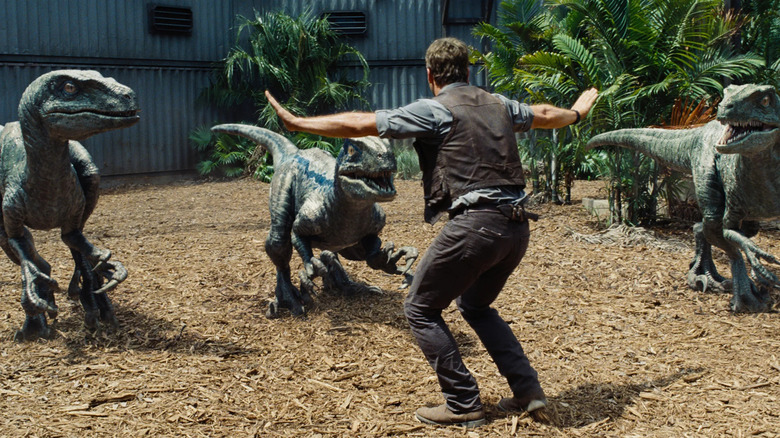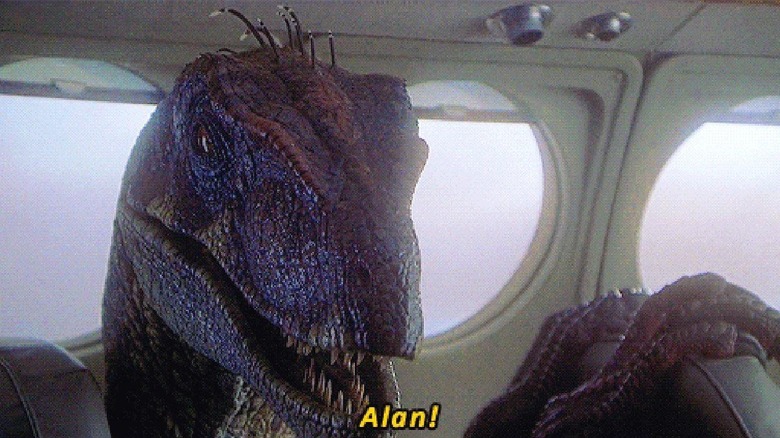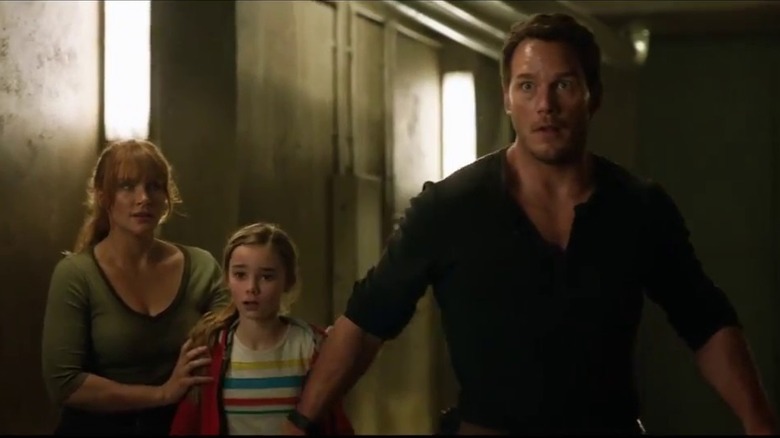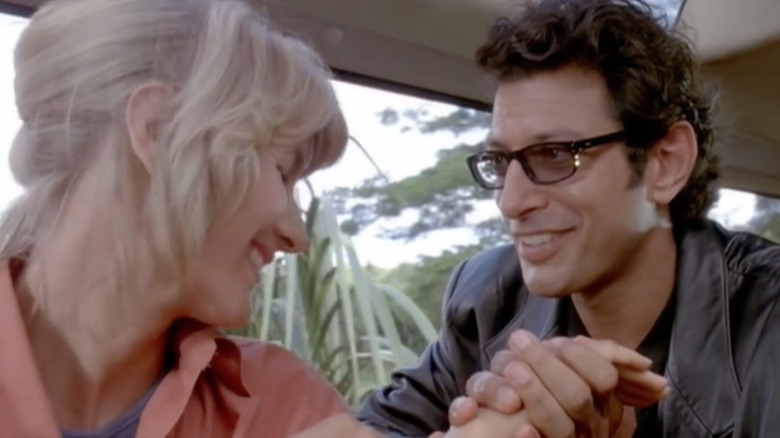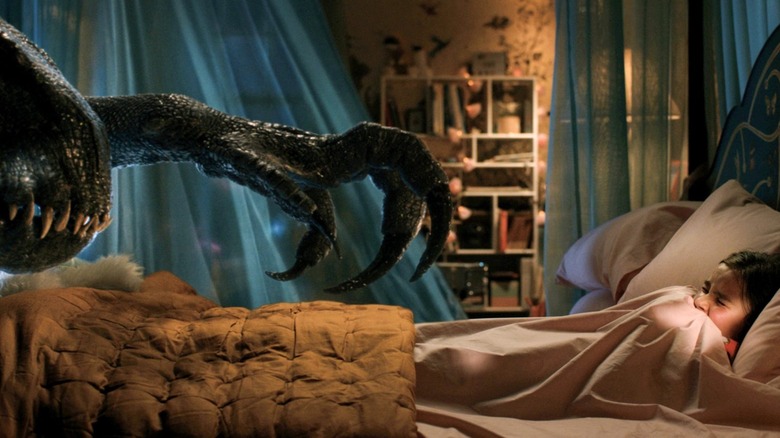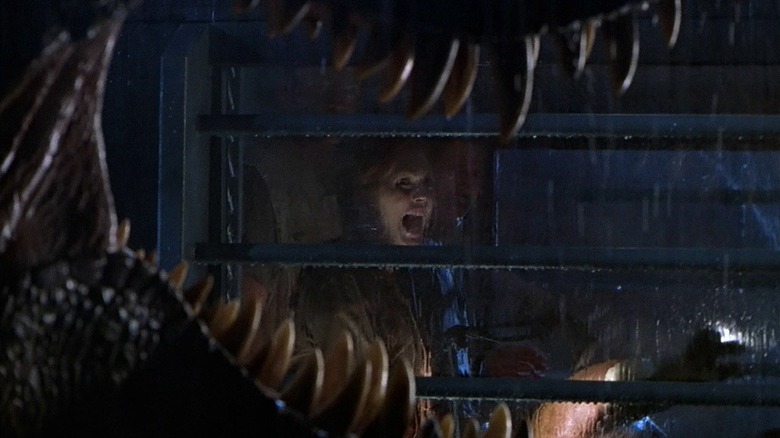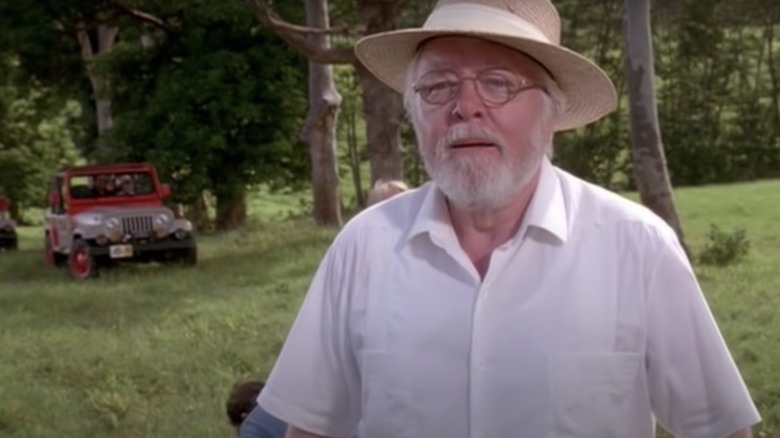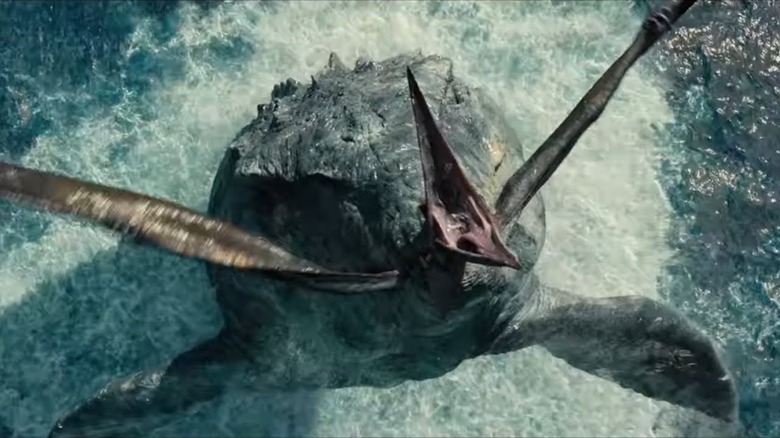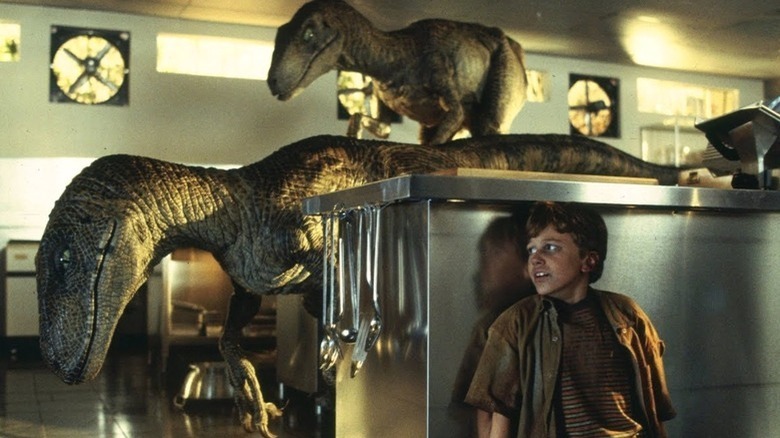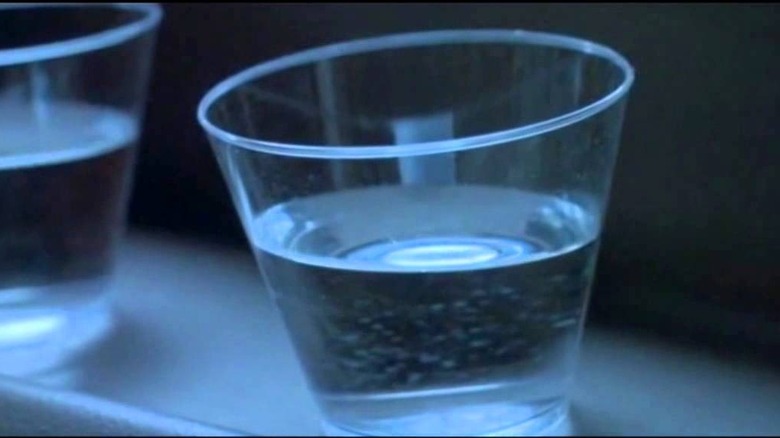The 10 Greatest Jurassic Park Moments
Cinema is arguably the greatest special effect ever conceived. The mere existence of motion pictures has become blasé by this point in history, but there was a time when it was an attraction unto itself. As major movie studios were constructed and the medium of film became not just commonplace but an entertainment business, filmmakers not only had to find new ways of drawing audiences in, but also found themselves enthralled with its possibilities.
The visual effects arms race, if you will, kicked into overdrive with the advent of movies like "Star Wars" and "Jaws," helping propel Hollywood into an era of blockbuster features that each strove to bring a seemingly impossible reality to the screen. "Jaws" director Steven Spielberg was one of the people at the forefront of this boundary-pushing, yet he also retained a sense of Old Hollywood-style ballyhoo and showmanship. In other words, his effects films actually delivered the goods.
Perhaps the most influential movie in a long line of watershed event films to feature pioneering visual effects, 1993's "Jurassic Park" was touted as "An Adventure 65 Million Years in the Making." The resulting film, with its ingenious blend of state-of-the-art animatronic creatures and cutting-edge computer graphics imagery (or CGI, as it's better known), delivered that promise and changed the landscape of cinema forever. It also kicked off a franchise that has never lost sight of its aesthetic mission statement: to provide visuals and moments that are utterly memorable.
In celebration of the final chapter of the "Jurassic" saga released this week, "Jurassic World Dominion," here are 10 of the greatest.
10. Controlling Raptors (Jurassic World)
Author Michael Crichton's concept for his original "Jurassic Park" novel was focused on how the genetic engineering of dinosaurs would be most applicable toward an entertainment venture, given how otherwise "there isn't any pressing need to re-create a dinosaur," as the writer explained. 2015's "Jurassic World" took that concept and ran with it, the titular theme park acting as a payoff to not just Crichton's concept but "Jurassic Park" the movie, with the dream of John Hammond (Richard Attenborough) fully realized.
But how would such a park run on a day-to-day basis, especially when the first "Jurassic" film showed how things could go very wrong before such a park could even be opened (and, indeed, given how very wrong things ultimately go for Jurassic World)? "Jurassic World" answers that question almost immediately with the introduction of Owen Grady (Chris Pratt), an ex-Navy ethologist who develops a tenuous mastery of arguably the meanest and most independent species of dinosaur, the Velociraptor.
Even in his introductory scene, where Owen bravely steps into the raptor pen to calm down the flock after a worker falls inside by accident, the raptors aren't fully subservient to him. Yet Owen is nonetheless able to hold the raptors at bay, resulting in not just a meme-able moment but one that sells the idea that Jurassic World just might work.
9. The Talking Raptor (Jurassic Park III)
The "Jurassic Park" films have made a habit of delving into various tones and genres, from straight-up horror to comedy to science-fiction. Even so, it's surprising that "surrealism" is one of those genres. Yet, in "Jurassic Park III," there it is: a talking velociraptor.
The moment occurs as part of a dream sequence, of course, one had by Alan Grant (Sam Neill). Yet there are unique elements surrounding the sight of a raptor saying Alan's name that help the moment stand out: for one thing, the dream visually illustrates Alan's fear and anxiety about returning to the island full of dinosaurs that nearly caused him to lose his life years earlier, and director Joe Johnston brings an eerie mood to the sight of Alan on an empty airplane before the raptor shows up. For another, Alan has recently learned through his research that Raptors had (or rather, have) a larynx for communication with each other, effectively enabling them to "speak," which is a plot point that comes into play later during "Jurassic Park III."
Moreover, the idea of a raptor speaking a human language is subversively hilarious, setting up this installment's playful sense of humor. And who knows — maybe this moment helped inspire the infamous 2005 "Jurassic Park 4" script by William Monahan and John Sayles that didn't get made.
8. Maisie's Secret (Jurassic World: Fallen Kingdom)
"Jurassic World: Fallen Kingdom" has a lot going on, and that's putting it mildly — the movie starts with the total volcanic destruction of Isla Nublar, and ventures into so many different concepts and genre riffs before culminating with all of the dinos being let loose en masse into the world, fulfilling the threat of eco-chaos established by the original "Jurassic" concept.
It's ironic, then, that one of the biggest game-changing plot developments in the movie is a little one, literally and figuratively: the fact that the young Maisie Lockwood (Isabella Sermon) is not the granddaughter of John Hammond's colleague Sir Benjamin Lockwood (James Cromwell), but rather the cloned version of Sir Benjamin's deceased daughter. The idea of the technology fostered by Hammond, Lockwood, and their corporate partners being applied to human beings seems like a concept almost wholly separate from the "Jurassic" series, and yet it's such a lateral move that it's a wonder it hadn't turned up in a sequel before this.
Whether you think it's an unwieldy misstep or a fascinating development that further exemplifies the ethically irresponsible idea behind the "Jurassic" films, it makes for a moment that's able to stand out in such an overstuffed entry in the series.
7. Ian Malcolm Explains Chaos Theory (Jurassic Park)
The "Jurassic" movies are more than just dino-sized spectacle. One of the most impressive aspects of the original film is how well-developed (not to mention well-cast) the human characters are, so much so that they would be able to carry the movie had the dinosaurs ended up not working.
For proof, look no further than Dr. Ian Malcolm (Jeff Goldblum) seductively explaining his theory of a chaos-ruled universe to Dr. Ellie Sattler (Laura Dern). The monologue perfectly explains Crichton's ethos regarding technology used irresponsibly and foreshadows the events to come within the film, as a chain of events instigated by Alan Grant leaving the jeep while Malcolm explains chaos theory (running to investigate a sick Triceratops) leads to the ensemble of characters becoming scattered across the island and entering into even more danger.
At the same time, the moment establishes the dynamic between the three leading adult characters of Ian, Ellie, and Alan, as Malcolm slyly flirts with the fascinated Ellie while Alan is hopelessly distracted. It proves that "Jurassic Park" has more on its mind than bringing dinosaurs to life.
6. The Indoraptor Stalks Maisie (Jurassic World: Fallen Kingdom)
The "Jurassic" sequels, like most sequels, have an escalation problem — they are in constant need of a bigger, badder dino villain. The "Jurassic World" trilogy has tried to attack this problem head on by acknowledging it in the body of the narrative, with the scientists at Jurassic World deliberately concocting a Frankenstein's monster of a never-was dinosaur, the Indominus Rex. "Fallen Kingdom" makes the obvious choice to bring the Indominus concept to the Velociraptor, making an "Indoraptor" that we're told has all sorts of crazy features, including being genetically unstable.
While all that verbal build up amounts to not much within the body of the film, director J.A. Bayona cleverly sidesteps the issue by adopting the "show, don't tell" ethos of movie making. Thus the Indoraptor becomes the series' first dinosaur that doesn't feel like an animal, the creature far more cunning and deliberately evil than any of her predecessors. Bayona visualizes this by having the Indoraptor stalk little Maisie throughout the creepy old Lockwood mansion in a manner that intentionally recalls Frank Langella's Dracula from the 1979 film of the same name.
The portrayal of a dinosaur as something akin to a Gothic horror creature makes "Fallen Kingdom" an entry not to be easily dismissed or overlooked, as it steers the series back toward the horror elements it had begun with.
5. The T-Rex Trailer Attack (The Lost World: Jurassic Park)
By the time he made "The Lost World: Jurassic Park," director Steven Spielberg was no stranger to sequels, and he knew that any sequel has to go bigger than the original. Spielberg and writer David Koepp's solution to the original film's T. Rex attack, then, was to simply add a second T. Rex. Oh, and to make sure both T. Rex's are furious at the puny humans inside a trailer on Isla Sorna who'd abducted their baby Rex (albeit for veterinarian care purposes).
While no one doubted Spielberg's mastery of choreography and suspense at that point in his career, the director nevertheless proves himself many times over with this one set piece. The tension is at an all-time high throughout the lengthy sequence, as not only are the lead characters trapped and in immediate danger, but the team's field equipment expert Eddie Carr (Richard Schiff) is menaced by the Rex family while he struggles to rescue the others once the dinos have toppled half of the large trailer over a perilous cliff.
It's a sequence that rivals Spielberg's "Indiana Jones" films in terms of it being a (literal) cliffhanger, and underlines just how perilous these movies can be for the very chewable humans caught in the middle.
4. 'Welcome to Jurassic Park' (Jurassic Park)
Steven Spielberg is known for his action choreography and suspense, but he's also famous for creating moments that contain a genuine sense of awe and wonderment, to the point where so many of his characters adopt the same wide-eyed gaze when faced with the immense and impossible that it's become a fully-fledged trope.
While other similar moments from "Close Encounters of the Third Kind" and "E.T. The Extra-Terrestrial" vie for the title, the introduction of Alan, Ellie, and Ian to the living dinosaurs of Jurassic Park is the single best distillation of Spielbergian awe. John Williams' majestic main theme for the film soars on the soundtrack while the scientists react with equal parts nervous disbelief, exuberant wonder and scholarly fascination (meanwhile, the shady lawyer Donald Gennaro simply sees giant dollar signs in place of the grazing brachiosauruses).
It's a scene that defines the "Jurassic Park" series, not just in tone, but in its proof-of-concept use of CGI to manifest the giant dinos on screen. It remains one of the most sincere moments in cinema history — which means, of course, it's since been parodied in increasingly ridiculous ways.
3. The Assistant's Death (Jurassic World)
Right from the opening scene of the first "Jurassic Park," it's clear that the victims of the out-of-control dinosaurs are likely to meet their untimely ends in an increasingly grisly and disturbing fashion. When director Colin Trevorrow rebooted the "Jurassic" films with "Jurassic World," he needed to establish just how disastrous a dinosaur outbreak with a park full of people would be.
Thus, the Pterosaur attack. Right from the start, things are hairy, as a flock of deadly Pterosaurs swoop down on an unsuspecting throng of tourists in the open-air concourse of the park. The Pterosaurs are far from the only breed of dinosaur in the park, however, and Trevorrow chronicles a particularly gnarly fate for the personal assistant to park operations manager Claire Dearing (Bryce Dallas Howard), Zara (Katie McGrath), who's attempting to chaperone Claire's nephews Gray (Ty Simpkins) and Zach (Nick Robinson).
First, Zara is plucked without warning from the ground high up into the air by a Pterosaur, only to be dropped from that height — right into the nearby show pool. Zara's safety is short-lived, however, as the Pterosaur is merely playing with its prey, swooping into the pool and grabbing the hapless assistant in its jaws. As a wise Jedi Knight once said, however, "there's always a bigger fish," and both the Pterosaur and Zara are swallowed whole by the water-based Mosasaurus. Worst babysitting job ever!
2. The Raptors Open the Door (Jurassic Park)
While the "Jurassic Park" series can't be called "educational" with a straight face, the movies at least gave audiences worldwide a newfound respect (not to mention fear) for these long-extinct animals. Where once upon a time it was easy to look at bones in a museum or illustrations in a book and think dinosaurs weren't very scary or intimidating, the "Jurassic" films proved us all very, very wrong.
There's no better example of this than the Velociraptor sequences in the first movie, which at times feels like a feature-length argument that raptors were the most formidable predators to have ever lived. The scene where Tim and Lex Murphy (Joseph Mazzello and Ariana Richards) are stalked by a pair of raptors inside the kitchen of the Jurassic Park visitor center is one of the most suspenseful and heart-pounding sequences of Spielberg's career, as the unarmed children seek to distract and outwit their clawed, toothy nemeses if they're to survive.
Yet the most chilling moment of this sequence occurs right at its start: our cast of characters learn that the raptors escaped their pen, and Sattler assures Grant that they've been contained. "Unless they've figured out how to open doors," she adds facetiously. Cut to a shot of a door handle being awkwardly pushed down, with a raptor breathing menacingly as the door opens. Before "Jurassic Park," only the biggest dino die-hards knew what a velociraptor was. After "Jurassic Park," everyone is now very, very aware of them.
1. The Glass of Water (Jurassic Park)
Despite all the great moments from the series, there's one distinct image that everyone who sees "Jurassic Park" has tattooed on their memory: the sight of water inside a glass gently, ominously rippling as a distant boom sounds in time with the ripples.
That image is representative of the terror, scale, and awe-inspiring adventure that Spielberg promises with "Jurassic Park" in general and the T-Rex escape scene in particular, and on all levels, he delivers. The mixture of the animatronics (designed by Stan Winston), the fluid CGI (composited by Dennis Muren and ILM), and the physical on-set effects (supervised by Michael Lantieri) bring the Rex to vivid life, the creature seeming real enough to be truly imposing and terrifying. The actors help sell the illusion, reacting with various levels of panic and fear that are all utterly believable. Editor Michael Kahn lends the sequence an incredible sense of timing, and sound designer Gary Rydstrom blends the sounds of a baby elephant's squeal, an alligator's gurgle, and a tiger's snarl to give the Rex a deafening, and defining, roar.
From there, Spielberg keeps the suspense high at all times, putting various characters in jeopardy and raising the stakes by having the Rex eat a man alive (so long, Mr. Gennaro). As the Rex causes havoc and escalates the terror, she behaves in a manner that's befitting any large animal. This isn't a sci-fi creature like the Indo-dinos from "Jurassic World," nor is it the "King Kong"-esque Rexes of "The Lost World" and "Jurassic Park III." This is an ancient predator returned to life.
Dinosaurs will never walk the Earth again (nor should they, as the series seems to argue), yet the "Jurassic Park" movies make that somewhat sad truth easier to accept. The films didn't just rekindle a fascination with the extinct animals, but gave them a new form of life, actually resurrecting them in the modern age ... if only on movie screens. In this way, the "Jurassic" series isn't just an exciting blockbuster franchise, but a perfect example of the magic movies can create, whether they were 65 million years in the making or just a couple.
